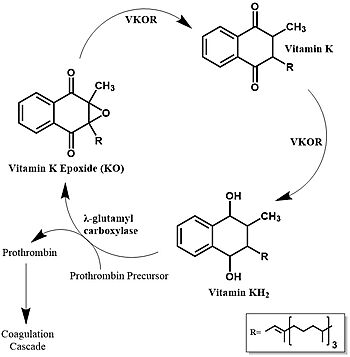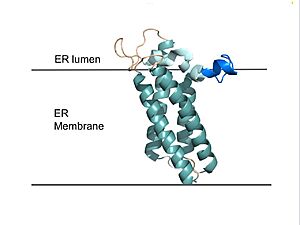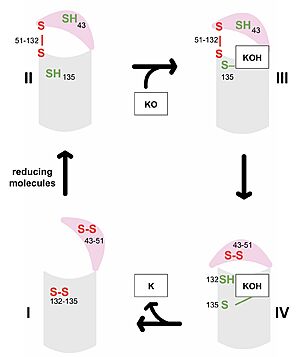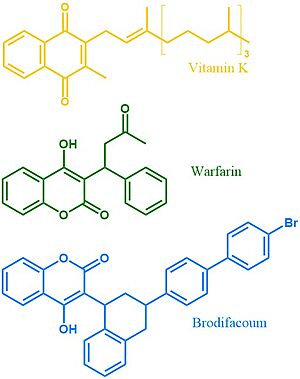Sandbox Reserved 1725
From Proteopedia
(Difference between revisions)
| (79 intermediate revisions not shown.) | |||
| Line 1: | Line 1: | ||
| - | {{Template:CH462_Biochemistry_II_2022}}<!-- PLEASE ADD YOUR CONTENT BELOW HERE --> | + | –{{Template:CH462_Biochemistry_II_2022}}<!-- PLEASE ADD YOUR CONTENT BELOW HERE --> |
==Vitamin K Epoxide Reductase== | ==Vitamin K Epoxide Reductase== | ||
| - | <StructureSection load='' size='340' side='right' caption=' | + | <StructureSection load='1stp' size='340' side='right' caption='Overall Structure of Vitamin K Epoxide Reductase' scene='90/904329/Vkoroverallblue/6'> |
== Introduction == | == Introduction == | ||
Vitamin K epoxide reductase (VKOR) is the enzyme responsible for regenerating vitamin K from vitamin K epoxide to support blood coagulation. | Vitamin K epoxide reductase (VKOR) is the enzyme responsible for regenerating vitamin K from vitamin K epoxide to support blood coagulation. | ||
| + | [[Image:Vitamin_k_cycle_5.jpg|350 px|left|thumb|'''Figure 1. Vitamin K Cycle''' The three states of Vitamin K are shown along with important enzymes, including VKOR. ]] | ||
=== Vitamin K Cycle === | === Vitamin K Cycle === | ||
| - | [ | + | [https://en.wikipedia.org/wiki/Vitamin_K Vitamin K] is essential for [https://en.wikipedia.org/wiki/Coagulation#Coagulation_cascade blood clotting] in the body and is recycled by means of the Vitamin K Cycle <ref name="Stafford">PMID:16102054</ref> (Figure 1). The fully reduced form, KH2, is used by [https://en.wikipedia.org/wiki/Gamma-glutamyl_carboxylase#:~:text=Gamma-glutamyl%20carboxylase%20is%20an%20enzyme%20that%20catalyzes%20the,of%20the%20encoded%20enzyme%20is%20essential%20for%20hemostasis gamma-glutamyl carboxylase] to carboxylate protein-bound glutamate residues in blood clotting cofactor precursors <ref name="Blanchard">PMID:6165889</ref>. After carboxylation, the clotting cofactors (such as [https://proteopedia.org/wiki/index.php/Thrombin prothrombin]) can bind to calcium and can proceed to the coagulation cascade <ref name="Swanson">PMID:6758841</ref>. During this process, KH2 becomes oxidized to Vitamin K epoxide, or KO <ref name="Blanchard">PMID:6165889</ref>. VKOR turns the epoxide back to the fully reduced form so the reduced form can be used again. This transformation happens in two steps: 1) converting the epoxide to the partially oxidized Vitamin K quinone and 2) converting the quinone to the fully reduced hydroquinone (KH2) (Figure 1) <ref name="Stafford">PMID:16102054</ref>. |
| - | + | ||
| + | [[Image:VKOR_in_membrane.jpg|300 px|right|thumb|'''Figure 2. VKOR in Membrane''' Transmembrane helices are teal. The tan sections are the loops (loop 1, beta hairpin, cap loop, 3-4 loop). The cap helix is light blue and the anchor is dark blue.]] | ||
| + | |||
| + | ==Protein Structure== | ||
=== Structural Overview === | === Structural Overview === | ||
| - | VKOR consists of four <scene name='90/904330/ | + | VKOR consists of four <scene name='90/904330/Transmembranehelices1/5'>transmembrane helices</scene> embedded in the endoplasmic reticulum membrane (Figure 2). Helices one and two are <scene name='90/904330/Betahairpin2/5'>connected</scene> by <b><span class="text-brown">Loop 1</span></b> and the <b><span class="text-orange">beta hairpin</span></b> region which contains two of the active cysteines, Cys43 and Cys51; these cysteines, along with Cys132 and Cys135, are essential for reduction and structural changes discussed in the next section<ref name="Liu">PMID:33154105</ref>. VKOR also has a <scene name='90/904330/Capdomain/3'>cap domain</scene> consisting of a <b><span class="text-blue">helix</span></b>, <b><span class="text-lightmagenta">loop</span></b>, and <b><span class="text-olive">anchor</span></b>. The <b><span class="text-olive">anchor</span></b> stabilizes the cap domain by attaching it to the surface of the ER membrane<ref name="Liu">PMID:33154105</ref>. The <b><span class="text-lightmagenta">loop</span></b> helps stabilize one of the substrate-binding amino acids, Asn80<ref name="Liu">PMID:33154105</ref>. The <b><span class="text-blue">helix</span></b> is involved in stabilization of certain disulfide bonds and structural changes as part of the catalytic cycle discussed below<ref name="Liu">PMID:33154105</ref>. |
| + | |||
| + | === Author's Note === | ||
| + | In order to deduce VKOR structures, Liu <ref name="Liu">PMID:33154105</ref> and colleagues used various strategies worthy of note. They incorporated a barrel-like domain that is not part of the catalytic VKOR protein to help with stability during experimentation. In some of the resolved structures, a catalytic cysteine was mutated to serine to force the reaction to stop with VKOR in that certain conformation. Also, due to stability issues, some of the experiments used human VKOR and others used VKOR of ''Takifugu rubripes'' which is similar to humans. The barrel domain has been removed from all structures used in this page and the amino acids renumbered to more closely match the published numbering in the referenced article <ref name="Liu">PMID:33154105</ref>. | ||
| + | |||
| + | === Active Site === | ||
| + | VKOR uses two substrate-binding amino acids, <scene name='90/904329/Kohhbond/4'>Tyr139 and Asn80</scene> to stabilize vitamin K in the binding pocket. Tyr139 and Asn80 hydrogen bond to carbonyl groups on vitamin K and stabilize it within the binding pocket <ref name="Liu">PMID:33154105</ref>. Vitamin K is also bound via hydrophobic interactions within the binding pocket of VKOR. Hydrophobic residues of VKOR, such as <scene name='90/904329/Kohydroaa/5'>Phe83, Phe87, Tyr88</scene>, form a hydrophobic tunnel within the binding pocket <ref name="Liu">PMID:33154105</ref>. | ||
== Catalytic Cycle == | == Catalytic Cycle == | ||
| - | |||
| - | ===Overview=== | ||
===Catalytic Cysteines=== | ===Catalytic Cysteines=== | ||
| + | The catalytic cycle of VKOR includes transitions from open to closed conformations by means of disulfide bridge-induced conformational changes (Figure 3). Open conformations (I & II) of VKOR exist when there is no ligand within the binding pocket. Closed conformations (III & IV) exist when some substrate exists within the binding pocket of VKOR. The substituent cysteines (I) act as reducing agents for the substrate, which can be either Vitamin K epoxide (KO) or partially reduced Vitamin K. | ||
| - | VKOR | + | [[Image:VKOR_Catalytic_cycle.jpg|300 px|right|thumb|'''Figure 3. Catalytic Cycle of VKOR''' VKOR's luminal domain is represented by a the pink semicircle and the transmembrane domain is represented by the gray cylinder. Step I and II represent open conformations of VKOR and steps III and IV represent closed conformations.]] |
| - | + | The first step <scene name='90/904329/Cat_cycle_i/7'>(step I)</scene> of the catalytic cycle (Figure 3) is the wild type open conformation. This step is characterized by an open cap domain with disulfide bonds between cysteines 43 and 51 and between cysteines 132 and 135 <ref name="Liu">PMID:33154105</ref>. The second step <scene name='90/904329/Cat_cycle_2/8'>(step II)</scene> of the catalytic cycle is a partially oxidized open conformation. This step is characterized by a disulfide bond between the luminal and transmembrane domain (Fig 3, step II). The transmembrane domain contains a free Cys135 and the luminal domain contains a free Cys43 <ref name="Liu">PMID:33154105</ref>. Step II is labeled as open because no ligand exists within its binding pocket despite the disulfide bridge that connects the luminal and transmembrane domains. The next step of the cycle <scene name='90/904329/Cat_cycle_3/8'>(step III)</scene> is a closed structure with an intact disulfide bond between Cys51 and Cys132. Cys135 is not involved in a disulfide bridge and instead reacts with substrate by forming a stable adduct with KOH or K. This binding induces the closed conformation and uses Cys43 in the luminal membrane for electron transfer <ref name="Liu">PMID:33154105</ref>. The final step <scene name='90/904329/Cat_cycle_4/4'>(step IV)</scene> of the catalytic cycle is the last closed conformation. The Cys51-Cys132 bond is broken as Cys43 bonds with Cys51, recreating the disulfide bridge pattern of the open state. Cys132 is then free to bond with Cys135, releasing the product that was bound to the Cys135. Overall the catalytic cycle of VKOR is dependent on open and closed conformational changes of the protein and ultimately is used to generate vitamin K from vitamin K epoxide <ref name="Liu">PMID:33154105</ref>. | |
| + | == Medical Relevance == | ||
| + | ===Warfarin=== | ||
| + | [https://en.wikipedia.org/wiki/Warfarin Warfarin] is the most widely prescribed oral anticoagulant and targets blood clotting via inhibition of VKOR. The FDA approves the use of Warfarin for cardiac conditions ([https://en.wikipedia.org/wiki/Myocardial_infarction myocardial infarction], [https://en.wikipedia.org/wiki/Atrial_fibrillation atrial fibrillation]) as well as for [https://en.wikipedia.org/wiki/Deep_vein_thrombosis deep vein thrombosis] and [https://en.wikipedia.org/wiki/Pulmonary_embolism pulmonary embolism]. Due to the inhibition of the normal blood clotting cycle, patients taking warfarin are at risk for hemorrhage which can occur anywhere in the body. <ref name="Patel">PMID:29261922</ref> | ||
| - | === | + | Warfarin is a <scene name='90/904330/Bothsubstratevkor/8'>structural mimic</scene> of Vitamin K that occupies the VKOR binding site, acting as a competitive inhibitor. Warfarin mimics vitamin K by binding to the same <scene name='90/904329/Warfarinhbond/7'>substrate binding residues</scene>(Asn80 and Tyr139) in the active site. Warfarin also shares the same <scene name='90/904329/Warfarinhydroaa/2'>hydrophobic interactions</scene> within the binding site that KOH experiences (Phe83, Phe87, and Tyr88). Warfarin binding also depends on the VKOR catalytic cysteines. Warfarin is able to bind to the fully oxidized open form of VKOR as shown in <scene name='90/904330/Cat_cycle_step1_warf/1'>step I</scene> of the catalytic cycle. Once Warfarin binds, VKOR is considered to be in a closed conformation since the substrate cannot enter, despite the lack of disulfide bridge changes. Warfarin can also bind to the partially oxidized form of VKOR as shown in <scene name='90/904330/Cat_cycle_step2_warf/1'>step II</scene> of the catalytic cycle. |
| + | There are around 30 known missense mutations that lead to warfarin resistance in patients, but these mutations do not affect Vitamin K binding for reasons which are not yet fully understood. Such patients require higher doses of warfarin to reach therapeutic level or require a different anticoagulant drug. <ref name="Wu">PMID:29743176</ref> | ||
| - | === Hydrophobic Interactions === | ||
| - | |||
| - | == Medical Relevance == | ||
| - | |||
| - | ===Warfarin=== | ||
| - | Warfarin is a structural mimic of Vitamin K that is used clinically as an anticoagulant. | ||
===Superwarfarins=== | ===Superwarfarins=== | ||
| - | + | [[Image:VKOR_Substrates2.jpg|300 px|left|thumb|'''Figure 4. Vitamin K, Warfarin, and Brodifacoum''' Above is a comparison of the 2D structures of VKOR's natural substrate, the blood thinner warfarin, and the superwarfarin brodifacoum.]] | |
| - | + | More potent warfarin derivatives, called [https://en.wikipedia.org/wiki/Superwarfarin superwarfarins], are used as rodenticides. The duration of one superwarfarin, [https://en.wikipedia.org/wiki/Brodifacoum brodifacoum], has been reported as 15-30 days <ref name="Chong">PMID:31857739</ref> vs. the clinical warfarin duration of 2-5 days<ref name="Patel">PMID:29261922</ref>. Superwarfarins have bulkier side chains that allow them to stay bound to VKOR for long periods of time, causing prolonged and uncontrolled bleeding<ref name="Chong">PMID:31857739</ref>. The <scene name='90/904330/Brodifacoumb/12'>enhanced binding</scene> is due to interactions between the bulky side chains and the hydrophobic residues of VKOR's binding pocket, as shown in brodifacoum. | |
</StructureSection> | </StructureSection> | ||
Current revision
–
| This Sandbox is Reserved from February 28 through September 1, 2022 for use in the course CH462 Biochemistry II taught by R. Jeremy Johnson at the Butler University, Indianapolis, USA. This reservation includes Sandbox Reserved 1700 through Sandbox Reserved 1729. |
To get started:
More help: Help:Editing |
Vitamin K Epoxide Reductase
| |||||||||||
References
- ↑ 1.0 1.1 Stafford DW. The vitamin K cycle. J Thromb Haemost. 2005 Aug;3(8):1873-8. doi: 10.1111/j.1538-7836.2005.01419.x. PMID:16102054 doi:http://dx.doi.org/10.1111/j.1538-7836.2005.01419.x
- ↑ 2.0 2.1 Blanchard RA, Furie BC, Jorgensen M, Kruger SF, Furie B. Acquired vitamin K-dependent carboxylation deficiency in liver disease. N Engl J Med. 1981 Jul 30;305(5):242-8. doi: 10.1056/NEJM198107303050502. PMID:6165889 doi:http://dx.doi.org/10.1056/NEJM198107303050502
- ↑ Swanson JC, Suttie JW. Vitamin K dependent in vitro production of prothrombin. Biochemistry. 1982 Nov 9;21(23):6011-8. doi: 10.1021/bi00266a044. PMID:6758841 doi:http://dx.doi.org/10.1021/bi00266a044
- ↑ 4.00 4.01 4.02 4.03 4.04 4.05 4.06 4.07 4.08 4.09 4.10 4.11 Liu S, Li S, Shen G, Sukumar N, Krezel AM, Li W. Structural basis of antagonizing the vitamin K catalytic cycle for anticoagulation. Science. 2020 Nov 5. pii: science.abc5667. doi: 10.1126/science.abc5667. PMID:33154105 doi:http://dx.doi.org/10.1126/science.abc5667
- ↑ 5.0 5.1 Patel S, Singh R, Preuss CV, Patel N. Warfarin PMID:29261922
- ↑ Wu S, Chen X, Jin DY, Stafford DW, Pedersen LG, Tie JK. Warfarin and vitamin K epoxide reductase: a molecular accounting for observed inhibition. Blood. 2018 Aug 9;132(6):647-657. doi: 10.1182/blood-2018-01-830901. Epub 2018, May 9. PMID:29743176 doi:http://dx.doi.org/10.1182/blood-2018-01-830901
- ↑ 7.0 7.1 Chong YK, Mak TW. Superwarfarin (Long-Acting Anticoagulant Rodenticides) Poisoning: from Pathophysiology to Laboratory-Guided Clinical Management. Clin Biochem Rev. 2019 Nov;40(4):175-185. doi: 10.33176/AACB-19-00029. PMID:31857739 doi:http://dx.doi.org/10.33176/AACB-19-00029
Student Contributors
Izabella Jordan, Emma Varness




